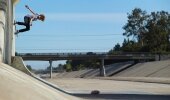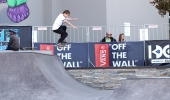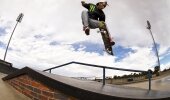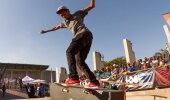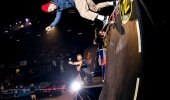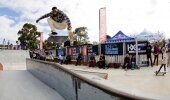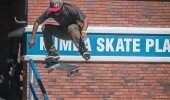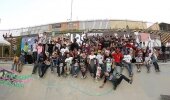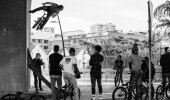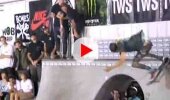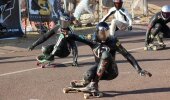Words: Shawn van Zyl | Photos: Peter Hudson | Video: Concrete Foundation Crew
If you've watched the filmS Dredd, Taxi 2, Dhoom 3 or Casino Royale and were impressed with the characters’ daredevil antics of nimbly climbing buildings, running over rooftops and vaulting effortlessly from ledges and protruding objects, what you saw was a demonstration of elements of parkour and free running.
DO IT NOW caught up with Shawn van Zyl, a practitioner of the Concrete Foundation Crew, to find out more about parkour, a movement culture that has found new life in natural and modern urban environments, and the sport that developed from it, free running.
Q: What is parkour and free running?
Parkour is a non-competitive art form that involves using your body to move efficiently and swiftly through any natural environment. A male practitioner of parkour is generally called a 'traceur' and a female a 'traceuse'. The goal of a practitioner is to develop his/her body while perfecting a vocabulary of techniques to achieve a certain level of mastery over the natural environment that we live in. Effective parkour techniques depend on fast redistribution of body weight and the use of momentum to perform seemingly difficult or impossible body manoeuvres at great speed. Absorption and redistribution of energy is also an important factor, such as body rolls when landing, which reduce impact forces on the legs and spine and allows a traceur to jump from greater heights than those often considered sensible in other forms of acrobatics and gymnastics.
According to David Belle, who is considered to be the founder of parkour, the practice is to move in such a way that will help you gain the most ground as if escaping or chasing something. Traceurs learn to take the fastest route from point A to point B and overcome any obstacle in their way in an instant. They are masters of chase or escape.
Free running (FR) is an extension of parkour and includes combinations of gymnastics or acrobatics moves. It is much more expressive than parkour and practitioners of free running are known as free runners. Like parkour, there is a heavy emphasis on efficient and silent movement, but free runners do not move with any specific direction or destination in mind. Instead, they see the landscape as their canvas and potential motion as the art that fills it. Free runners will run up walls and do back flips, twists and spin all over the place with graceful, flowing movements that are inspired by many other art forms.
Sébastien Foucan, who is believed to be the founder of free running, said, "Free running is the art of expressing yourself in your environment without limitations: it is the art of movement and action." He says free running developed from parkour when he started making it more personal to the individual, adapting it to each person's strengths and weaknesses.
When was it invented?
Martial artists and people in general have been practicing and mastering the principles of parkour and free running for thousands of years. Having said that, it was only really developed into a curriculum with specific names used to describe specific moves in the last 17 years.
As teenagers, David Belle (parkour) and Sébastien Foucan (free running) used to play in their neighbourhood pretending to be super heroes. In time and with practise, they began to master their skills, and with the use of YouTube and social media the world began to watch. David and Sébastien were part of the very first parkour team or group, called the Yamakasi, which included Châu Belle Dinh, Williams Belle, Yann Hnautra, Laurent Pietmontesi, Guylain N'Guba Boyeke, Malik Diouf and Charles Perriére. This team of individuals began to popularise and define these two disciplines throughout the 1990s and into 2000.
Who can join and what do they need to do?
Parkour and free running is like a coin with two faces. On the one side, the emphasis is on returning full strength, flexibility and balance to the body. This is the most important aspect of these art forms as it will ensure a solid foundation from which to start your journey. The other side of the coin is the actual playtime of parkour and free running. This is called jamming and involves putting your new-found strength and techniques to use in the real world.
These disciplines can be practiced by people of all age groups, fitness levels and gender. Practitioners start off slowly, first building up their strength and flexibility bit by bit, and then move at their own safe pace thereafter. There are even parents in the US aged between 30 and 50 doing parkour.
When was the Concrete Foundation Crew formed?
The Concrete Foundation Crew was formed back in 2009 by a group of six practitioners. Our goal back then was to help educate and grow parkour and free running in South Africa by holding workshops and building public training spots for local communities. Most of the original members are now professional athletes, working as full-time performers or stuntmen on feature films, such as the 2012 Dredd and the soon to be released Mad Max 4.
Where are sessions held and at what time?
Training and conditioning takes place in Johannesburg:
• Every Monday to Thursday at the Sandton George Lea Sports Park from 5 p.m. to 7 p.m. Here, all the techniques are practised, as well as conditioning designed to build the explosive strength, balance and flexibility that's needed in parkour and free running.
• Every Friday night from 7 p.m. to 9 p.m. and Sunday afternoons from 3 p.m. to 5 p.m. at the JGC Women's Gymnasium in Newlands. This is where the more tricky and risky movements are mastered.
• Every Saturday from 9 a.m. at Wits, and this is the most popular meet.
Parkour and free running - These are not the same thing and quite different from each other in their purpose and goals.
Parkour shows - There is no such thing as performing a parkour show. If you see any presentations of parkour purely for the sake of entertainment it cannot be defined as parkour, simply because you are not following the principles of what parkour is. You can take the movement from parkour and use it to entertain, but the end result cannot ethically be called parkour as it doesn’t follow the principles of the discipline.
Flips
- Many people get confused when they see someone who calls themselves a traceur doing flips and spins. Just because someone does these things does not mean the actions constitute parkour, it just means that the traceur trains in other aspects of movement as well as parkour. If you are unsure simply ask yourself, if you were running for your life what would you do?
Parkour is an urban sport - Parkour was developed and practiced in the trees and forests of France just as much as in the cities. It is practised to great effect in natural environments that have been shaped by time and the elements, and can be rough and jagged as opposed to the smoothed and usually symmetrical man-made urban environment.
dinFO:
To get involved or find out more information, email or via Facebook: www.facebook.com/concretefoundationcrew. Alternatively, you can visit our website at www.cfgymnat.com.
For more information for training sessions in other areas see below:
Durban:
• Jam sessions: Westville Campus (www.facebook.com/DurbanParkourNews?fref=ts)
Cape Town:
• Gymnastic sessions: UCT gymnastics (Tuesday and Thursday evenings)
• Jam sessions: PKCT/ Western Cape (www.facebook.com/pages/PKCT/125822855666)
